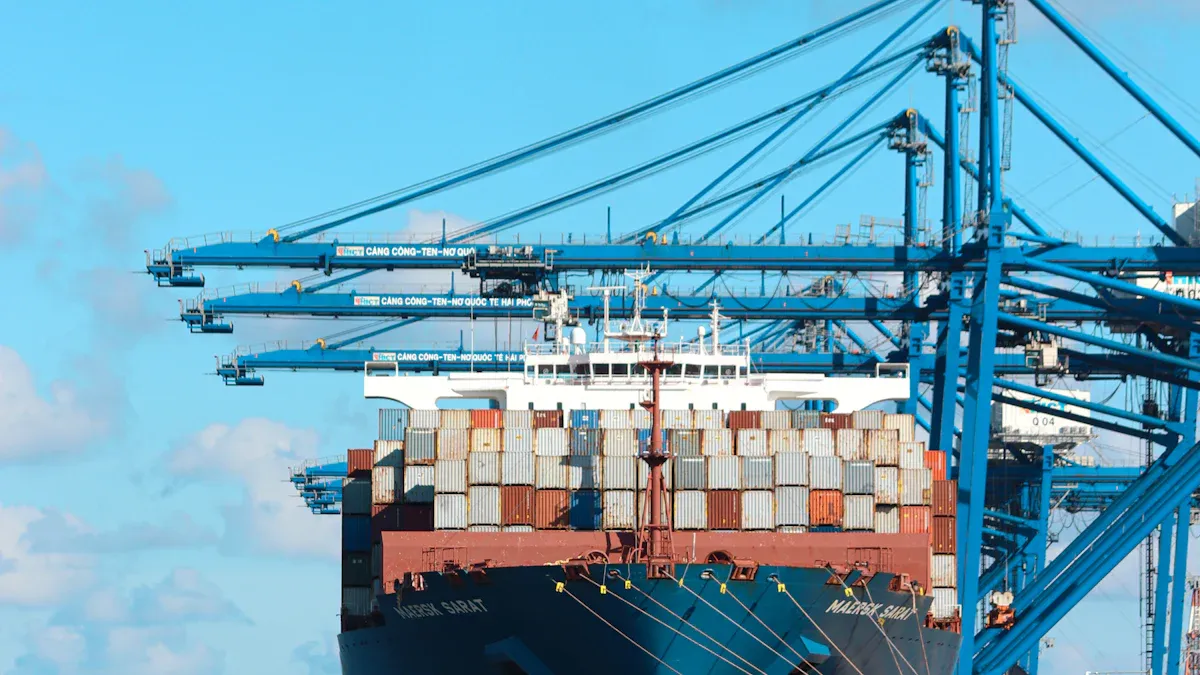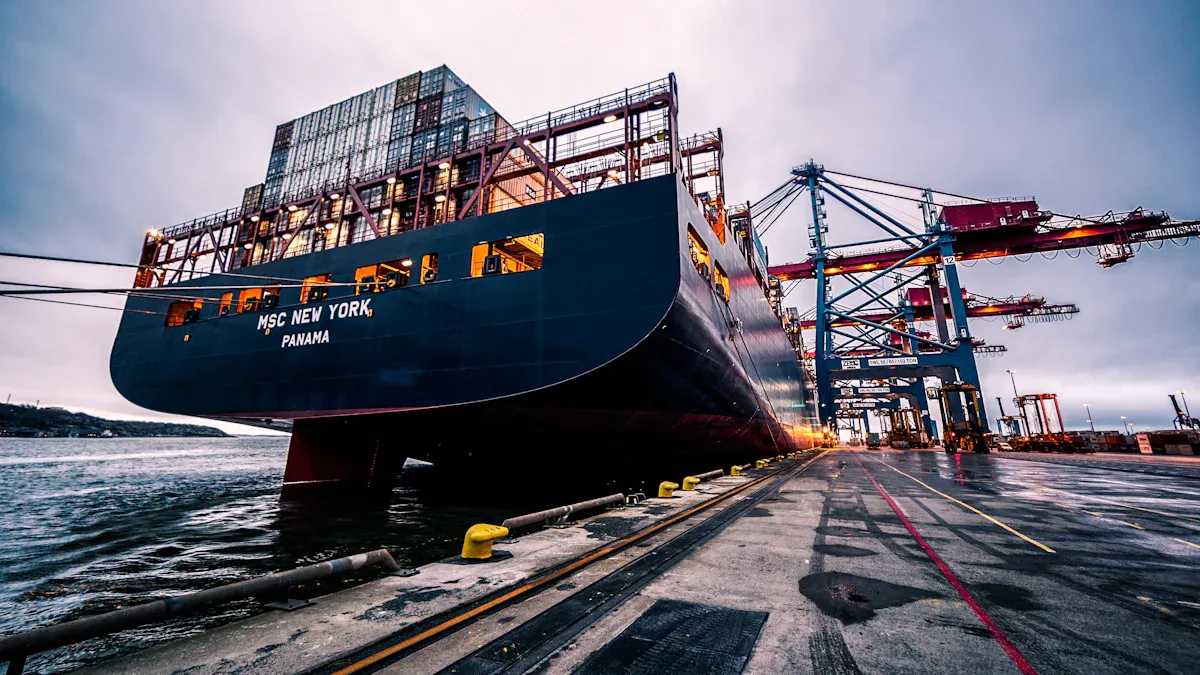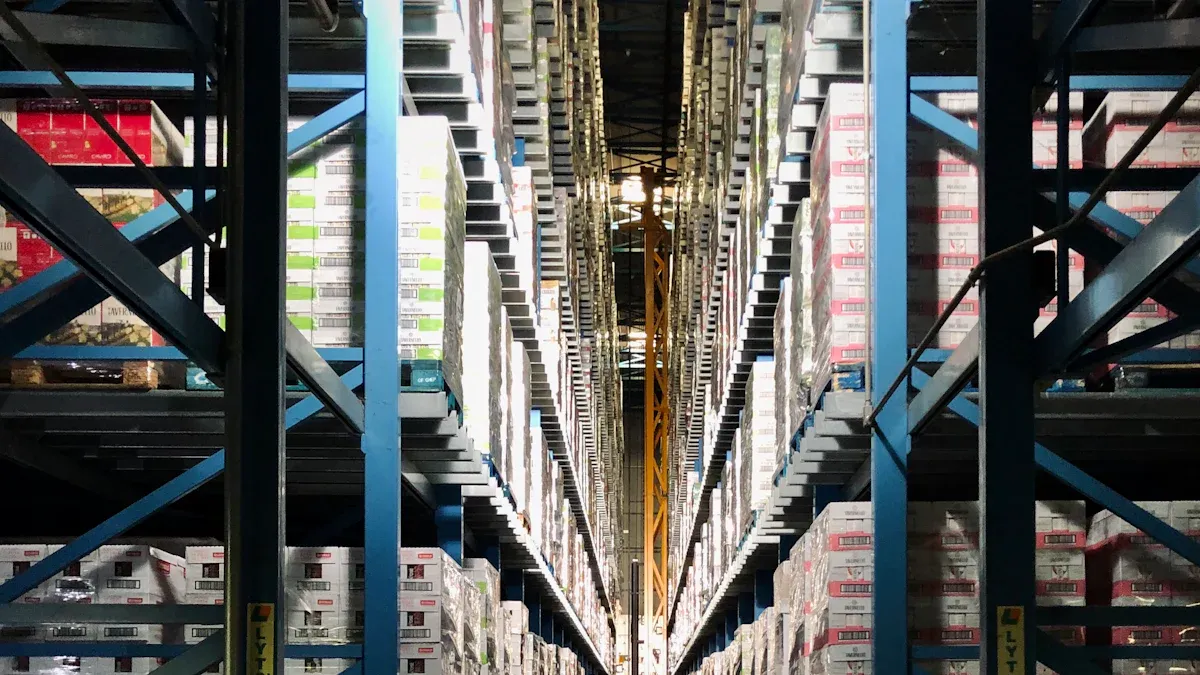A practical guide to global logistics network optimization

To optimize your global logistics network, you need to focus on strategic planning, regular monitoring, and ongoing improvements. Companies that follow these steps see strong results:
Outcome | Statistic |
|---|---|
Customer Satisfaction | 83% of supply chain leaders prioritize customer satisfaction. |
Logistics Costs | Logistics costs make up 30% of delivery costs. |
Efficiency Improvements | Early AI adopters report up to 30% efficiency gains. |
Strategic planning helps you solve daily problems and build for the future. The network global logistics guide shows that using new technologies and smart distribution planning can boost your results and keep customers happy.
Key Takeaways
Strategic planning is essential for optimizing your logistics network. Regularly review performance and seek areas for improvement.
Investing in technology and data analytics can lead to significant cost savings and efficiency gains in logistics operations.
Building strong relationships with suppliers and logistics partners enhances reliability and flexibility in your supply chain.
Sustainability practices not only benefit the environment but also attract customers who value eco-friendly companies.
Prepare for risks and disruptions by having contingency plans and using real-time tracking to manage your logistics effectively.
Network Global Logistics Guide

A network global logistics guide helps you understand how goods move across countries and continents. Logistics connects businesses to customers by making sure products reach the right place at the right time. You see the impact every day when you order something online and it arrives quickly. Logistics supports international trade by lowering costs and improving supply chain management. When companies invest in logistics infrastructure, they boost exports and imports. The table below shows how logistics performance affects trade:
Logistics Performance | Effect on Trade |
|---|---|
Overall Performance | Positive effect on exports and imports |
Specific Dimensions | Strong impact, especially on exports |
Key Elements
You need to focus on several critical parts when building a strong logistics network. Experts recommend these key elements:
Risk management helps you spot problems early and create backup plans.
Optimizing transportation routes saves money and time.
Efficient inventory management keeps products available and avoids shortages.
Warehousing and storage facilities protect goods until delivery.
Transportation and distribution channels connect warehouses to customers.
Inventory management systems track stock levels.
Technology and data integration allow you to follow shipments and make smart decisions.
Supplier and vendor relationships keep your supply chain reliable.
Customer fulfillment processes make sure orders arrive accurately and quickly.
A network global logistics guide shows that using these elements together creates a system that works smoothly.
Strategic Planning
You need a plan to make your logistics network work well. Strategic planning means you look at your current performance and find ways to improve. Follow these steps:
Review logistics performance often to spot areas for growth.
Collect and study data from different sources.
Use programs like Lean and Six Sigma to improve processes.
Test new technology with audits and pilot projects.
Check for risks and prepare backup plans.
Ask customers for feedback to make changes.
A network global logistics guide helps you align your logistics network with your business goals. You can analyze regional markets, choose the best transport modes, and use technology to make decisions. When you follow these steps, you build a network that supports your company’s success.
Benefits
Cost Savings
You can save a lot of money by optimizing your logistics network. When you use smart planning and technology, you cut down on transportation, warehousing, and inventory costs. Many companies report that network optimization can reduce supply chain costs by 10%. If you simplify your supplier network, you may cut procurement costs by 10–20%. These savings help your business stay competitive and invest in growth.
Tip: Review your logistics expenses often. Small changes in routes or storage can lead to big savings over time.
Efficiency Gains
A strong logistics network helps you work faster and smarter. You can deliver products more quickly by placing warehouses in the right locations and using advanced route planning. This means fewer delays and better use of your resources. Data analysis and technology let you manage inventory and staff more effectively. The table below shows some main benefits companies see after optimizing their logistics networks:
Benefit | Description |
|---|---|
Cost Efficiency | Lower expenses for transport, storage, and inventory. |
Improved Delivery Speed | Faster deliveries with better warehouse locations and route planning. |
Better Resource Utilization | Smarter use of inventory and staff through data and technology. |
Scalability and Flexibility | Easier to adjust to market changes and customer needs. |
Customer Satisfaction
When you improve your logistics network, your customers notice. They get their orders on time and with fewer mistakes. This leads to higher satisfaction and more repeat business. A network global logistics guide can help you focus on accurate order fulfillment and timely delivery. Happy customers trust your brand and often share their good experiences with others.
Remember: Satisfied customers are more likely to stay loyal and recommend your business to friends.
Challenges
Complexity
You face many sources of complexity when you manage a global logistics network. Many companies work with different suppliers, manufacturers, and carriers. These multi-enterprise networks make it hard to keep everything running smoothly. Outdated technologies and manual methods, such as EDI and phone calls, slow down your operations. You also deal with sudden changes from geopolitical events, new weather patterns, and more rules. These factors make your logistics network unpredictable and harder to control.
Multi-enterprise networks involve many stakeholders.
Outdated technologies and manual processes slow you down.
Geopolitical disruptions and changing weather add volatility.
New regulations increase the challenge.
Tip: You can reduce complexity by updating your technology and improving communication with all partners.
Regulatory Barriers
You must follow many rules when you move goods across borders. Each country has its own regulations and paperwork. If you do not follow these rules, you may face fines, delays, or even lose your goods. Managing compliance adds to your costs and makes your job more difficult. The table below shows some common regulatory barriers and their impact:
Impact on Operations | |
|---|---|
Protectionist Policies | Increases costs, causes delays, disrupts flow of goods |
Customs Regulations | Non-compliance leads to fines, delays, and seizures |
Compliance Challenges | Adds to operational costs, complicates logistics process |
You need to stay updated on changing regulations to avoid problems and keep your network running smoothly.
Risk and Disruptions
You face many risks that can disrupt your logistics network. These risks can cause delays, increase costs, or stop your operations. Some of the most common risks include:
Economic slowdowns
Business interruptions
Growing competition
Regulatory changes
Supply chain failures
Property damage
Work injuries
Geopolitical volatility
Weather or natural disasters
You need to prepare for these risks. Strong planning and quick response help you protect your business and keep your customers satisfied.
Optimization Strategies
You can make your logistics network stronger by following clear, practical steps. These strategies help you use data, technology, partnerships, and green practices to improve your results.
Data and Analytics
You need good data to make smart decisions. Centralizing your data lets you see the whole picture of your supply chain. When you use analytics tools, you can spot problems, find savings, and plan better routes. Many companies use these tools to get real-time updates and make quick changes.
Some of the most effective data and analytics tools for logistics network optimization include:
High Jump: Gives you real-time shipment information and detailed reports.
Cognos: Offers business intelligence and predictive insights for your supply chain.
Axway: Collects data and provides insights for freight operations.
TIBCO: Lets you visualize data and get real-time feedback.
Qlik: Helps you manage inventory and billing.
IMI by Aptean: Tracks shipments and analyzes warehouse operations.
FusionOps: Uses AI and big data for better predictions and operations.
Solvoyo: Combines planning and analytics for smoother operations.
TARGIT: Finds challenges and helps you create action plans.
Tableau: Makes it easy to handle inventory and manage routes.
You can use advanced analytics to:
Optimize routes by checking traffic, weather, and delivery times.
Predict delivery times with real-time tracking.
Measure how well your carriers and fleets perform.
Combine shipments to fill trucks and reduce trips.
Tip: Start by centralizing your data. This step makes it easier to spot trends and act quickly.
Technology and Automation
You can boost your logistics network by using the latest technology and automation. These tools help you work faster, cut costs, and reduce mistakes. Many companies now use artificial intelligence, robots, and smart sensors to improve their supply chains.
Technology/Trend | Description |
|---|---|
Artificial Intelligence | Predicts demand and manages inventory to avoid shortages. |
Automation | Uses robots and automated vehicles to speed up warehouse work and lower errors. |
Blockchain Technology | Keeps supply chains secure and transparent with digital records. |
Internet of Things (IoT) | Tracks shipments and inventory in real time, making operations smoother. |
Sustainability Initiatives | Uses green solutions like electric trucks and carbon-neutral shipping to meet customer demand. |
You can see these trends in action:
Amazon uses AI to move goods faster in warehouses.
IoT sensors check temperature and humidity for perishable goods.
Blockchain smart contracts pay suppliers automatically when shipments arrive.
Automation brings big savings and fewer errors. Research shows that companies with manual supply chains pay 15-20% more in operating costs than those with automation. Automation can cut error-related costs by up to 30% and reduce cycle times by 40-60%. Automated systems also let each worker process up to three times more orders.
Note: Automation frees up your team to focus on important tasks instead of repetitive work.
Strategic Outsourcing
You can improve your logistics network by working with outside partners. Strategic outsourcing lets you use the skills and resources of experts. Many top companies use this approach to save money, manage risks, and stay flexible.
Zara outsources logistics to respond quickly to fashion trends and keep inventory moving.
Unilever partners with logistics providers to cut costs and improve service.
Amazon uses third-party companies for last-mile delivery to reach customers faster.
When you outsource logistics, you can:
Save money by lowering your operating costs.
Manage risks better with help from specialists.
Focus on your main business while experts handle logistics.
Remember: Choose partners who share your goals and values for the best results.
Sustainability
You can build a stronger brand and save money by making your logistics network more sustainable. Many customers now prefer companies that care about the environment. Green practices like carbon-neutral shipping and electric delivery trucks help you meet this demand.
Recent studies show:
69% of consumers care more about sustainability now than in 2021.
Brands with green practices gain more loyal customers.
Social media shapes how people see your brand based on your eco-friendly actions.
Sustainable supply chains use less energy and work more efficiently.
Investors look for companies with strong sustainability records.
Tip: Share your green efforts with your customers. This builds trust and sets you apart from competitors.
A network global logistics guide can help you combine these strategies for the best results. You can use data, technology, partnerships, and green practices to build a network that is efficient, flexible, and ready for the future.
Technology in Logistics

Digital Tools
You can make your logistics network smarter by using digital tools. These tools help you track shipments, manage inventory, and plan routes. Many companies use advanced IT systems to improve their operations. Here are some of the most impactful digital tools you can use:
Warehouse Management System (WMS) helps you organize inventory and speed up order fulfillment.
Transportation Management System (TMS) lets you plan routes and manage freight with real-time updates.
Blockchain Technology keeps your data safe and tracks shipments securely.
Artificial Intelligence (AI) analyzes data and helps you make better decisions about inventory and delivery.
Cloud Computing gives you instant access to data and helps your team work together from anywhere.
GPS Tracking shows you where your vehicles are and helps you deliver orders on time.
Tip: You can combine these tools to get real-time information and make quick changes when needed.
When you use these digital tools, you can lower costs, reduce mistakes, and improve customer satisfaction. AI and analytics help you predict demand and avoid running out of stock. GPS tracking makes deliveries faster and more accurate.
Real-World Examples
Many companies have improved their logistics networks by using technology. You can learn from their success. The table below shows how three companies used digital tools and strategies to get better results:
Company | Strategy/Technology Implemented | Impact |
|---|---|---|
DSV | Invested in automation at order fulfillment centers | Modernized operations and expanded automation across facilities |
KLM Cargo | Used sustainable transportation models and green fuels | Lowered air freight costs and improved brand image while helping the environment |
UPS | Focused on healthcare logistics with advanced tracking and management | Supported medical supply chains and achieved higher turnover during the pandemic |
You can see that technology helps companies work faster, save money, and keep customers happy. Advanced IT systems let you reduce costs, cut carbon emissions, and improve efficiency. AI tools help you plan better routes and use your workforce wisely. Companies report up to three times more efficiency and five times lower costs after using these systems.
Note: You can start small with one tool and add more as your business grows.
Risk Management
Visibility
You need strong visibility to manage risks in your global logistics network. Real-time tracking gives you accurate and current information about your goods as they move. This helps you see where your shipments are at any moment. You can act quickly if something goes wrong.
Real-time tracking lets you spot problems before they grow.
You get updates on stock levels, which helps you avoid waste and lower storage costs.
You can talk to your partners and team members more easily, which leads to smoother operations.
Real-time data helps you make better choices, like finding faster delivery routes or giving customers accurate order updates.
Tip: Use GPS tracking and cloud-based systems to keep everyone informed and ready to respond.
You also need to check your processes often. Regular audits and training help you follow rules and keep your cargo safe. GPS tracking and good documentation protect your shipments. You should train your drivers and keep your vehicles in good shape to lower risks.
Contingency Planning
You must prepare for disruptions in your logistics network. Good contingency planning keeps your business running when problems happen. Start by looking at your risks and making a plan for each one.
Diversify your suppliers and manufacturing locations. This way, if one area has trouble, you can still get your goods.
Use technology like IoT sensors and AI-powered analytics to spot problems early and predict demand surges.
Build strong partnerships with reliable logistics providers. They can help you find solutions fast.
Train your team on emergency procedures and communication. Practice with drills so everyone knows what to do.
You should also use cloud-based transportation management systems. These tools give you real-time alerts and updates. They help you make quick decisions and keep your supply chain moving.
Remember: A good plan and the right tools help you handle disruptions and keep your customers happy.
You can optimize your logistics network by following clear steps. Start by setting goals, measuring performance, and gathering data. Improve communication, reduce costs, and invest in your team. Build strong supplier relationships and always have a backup plan.
Measure performance
Gather and analyze data
Improve communication
Reduce costs
Invest in employee development
Find dependable suppliers
Have a contingency plan
Continuous improvement helps you lower risks, save money, and avoid disruptions. Begin with data centralization and strategic planning. Talk with your leaders to set clear objectives and keep your project on track. As you monitor and adapt, you may face challenges like labor shortages, rising costs, and high customer expectations. The table below shows common issues:
Challenge | Impact |
|---|---|
Supply chain disruptions | Cost companies an average of $184 million annually |
Operational complexity | 73% of logistics managers report significant increase over the past two years |
Stay flexible and use technology to keep your logistics network strong for the future.
FAQ
What is a global logistics network?
A global logistics network connects suppliers, warehouses, and customers across countries. You use it to move goods quickly and safely. This network helps you deliver products on time and keep your business running smoothly.
How does technology improve logistics?
You use technology to track shipments, manage inventory, and plan routes. Digital tools give you real-time updates. These updates help you make better decisions and avoid delays.
Why should you focus on sustainability in logistics?
Sustainability helps you save energy and reduce waste. Customers trust companies that care for the environment. You can use electric trucks or eco-friendly packaging to show your commitment.
What is the first step to optimize your logistics network?
You start by collecting and centralizing your data. This step helps you see where you can improve. Data shows you which routes work best and where you can save money.
See Also
Key Strategies for Effective Management of Global Logistics
The Role of Direct Logistics in Enhancing Global Efficiency
Transforming International Operations Through Innovative Logistics Solutions
PGL's Specialized Knowledge in Global Logistics and Supply Chains
Top Global Logistics Services for Streamlined West Coast Trucking
